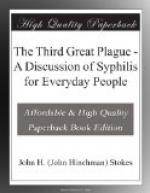+Transmission by Infected Articles.+—The feebleness of the germ and the ease with which it is destroyed are its redeeming qualities. This is of special importance in considering transmission by contact with infected articles. Nothing which is absolutely dry will transmit syphilis. Moisture is necessary to infection with it, and only articles which have been moistened, such as dressings containing the discharges, and objects, such as cups, eating utensils, pipes, common towels, and instruments which come in contact with open sores or their discharges, are likely to be dangerous. Moreover, even though these objects remain moist, the spirochetes are likely to die out within six or seven hours, and may lose their infectiousness before this. Smooth, non-absorbent surfaces, especially of metal, are unfavorable for the germ. Wash-basins, dishes, silverware, and toilet articles are usually satisfactorily disinfected by hot soapsuds, followed by drying. Barbers, dentists, nurses, and physicians who take care at least to disinfect instruments and other objects brought into contact with patients with carbolic acid and alcohol will never transmit syphilitic infection to others. Toilet-seats, bath-tubs, and door-knobs, although theoretically dangerous, are practically never so, and syphilitic infection transmitted by them can be dismissed as all but unknown. This is in marked contrast to gonorrhea, which in the case of little girls can be transmitted apparently by toilet-seats. Much depends, as has been said, on placing the germ on a favorable ground for inoculation, and the bare skin, unless the virus is massaged or rubbed in, is certainly not a favorable situation. Many experts do not hesitate to handle infectious lesions with the fingers provided the skin is not broken, relying simply on the immediate use of soap and water, and perhaps alcohol, to remove the germ. While this may be a risk, it should, none the less, reassure those who are inclined to an unreasoning terror of infection whenever they encounter the disease.
+Transmission Under the Conditions of Every-day Life.+—The question of just how dangerous the worker with foodstuffs may be to others when he has active contagious lesions is unsettled. Recent surveys of various types of workers have tended to show that syphilis in transmissible form is not especially prevalent among them. The same general principle applies here as elsewhere. The risk of infection with syphilis increases with dirty and unsanitary conditions, and becomes serious when there is opportunity for moist materials to be transferred to sensitive surfaces, like the mouth, sufficiently soon after they have left the syphilitic person for the germs to be still alive. That the real extent of the risk is not known does not make it any the less important that persons who have opportunity to handle materials in which this may occur should be subject to frequent sanitary inspection. Restaurants in which the silverware is not properly cleaned, and




